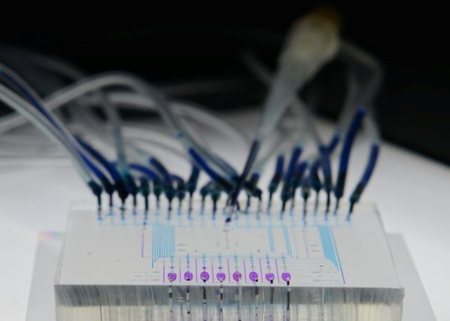北大在PNAS报道单细胞全转录组测序新技术
2014年4月29日,生物动态光学成像中心黄岩谊、汤富酬课题组在《美国科学院院刊》(PNAS)上发表题为Microfluidic single-cell whole-transcriptome sequencing的论文。该研究利用微流控芯片技术实现了高质量单细胞的全转录组测序样品准备,全面提高了单细胞全转录组分析的准确性和可靠性。

细胞是生命活动的基本功能单位,而在生物体内没有任何两个细胞是完全相同的。传统的生命科学与医学研究,绝大多数情况下都是针对混合的大量细胞进行的,无法观察到单个细胞之间细微的差别。近年来不断发展的实验技术,提供了更加定量与客观的证据,表明在许多关键生命过程例如胚胎发育、细胞分化、疾病发生与发展等过程中,特定的单个细胞行为,以及其间的个体化差异与异质性,导致了极其重要甚至是决定性的结果。而之前基于大量细胞平均测量所获得的结果并无法正确反映复杂生物体系的全面真实信息,严重掩盖了独立个体样本的行为以及生命现象中大量存在的随机行为。针对单个细胞的研究,是细胞生命分析技术所追求的极限状态,是对传统技术极大的挑战。
单细胞测序利用新一代的测序技术来分析单个细胞内的基因信息,成为解读单细胞的最佳工具。单细胞全转录组测序是单细胞高通量测序需求量最大的应用,它所测定的是单个细胞内所有基因的表达量,同时还可以测定除了mRNA分子外,其他长非编码rna(lncRNA)以及小RNA的含量,定量获取单个细胞完整的表达谱。目前采用的新一代测序技术中,绝大多数方法都需要特定的前处理过程,制备“测序文库”。而针对单细胞样品,已有的方法均存在很多缺陷,导致检测灵敏度不高、基因表达信息丢失严重、技术噪音高、操作失误率高、重复性差。
为了解决这一矛盾,两个课题组合作开发了新的文库制备方法,将最关键的单细胞转录组文库构建步骤集成在一个微流控芯片上,可以同时进行多个样品的操作。这一技术的开发,大大减少了试剂用量,在反应效率得到提升的同时极大地抑制了污染的发生,还减少了操作误差,实现了更高的可靠性和更好的平行性。
通过对几十个细胞的分析表明,这一方法可以有效地消除转录组高度动态特性所带来的测量差异,实现对单细胞异质性的分析和判断。通过多个细胞较低深度的转录组测序,可以获取比同等成本下单个细胞高深度测序更重要的细胞异质性信息,而更好地展现生物体系的复杂性、随机性和动态过程。而通过微流控芯片上的精确细胞操控和主动俘获过程,还可以摆脱其他类似方法中随机俘获的局限性,实现对极其少量细胞的完全俘获和反应前的表型观察,以更好地理解和验证单个细胞的异质性。与已有的技术相比,这一工作展示了目前最好的单细胞转录组测序检测灵敏度和平行性。
黄岩谊博士同时任北京大学工学院教授,汤富酬博士同时任北京大学生命科学学院研究员。黄岩谊组博士后Aaron Streets博士、赵亮博士和研究生张先念为论文的主要作者。这一工作得到了国家科技部973计划、863计划、国家自然科学基金委及霍英东教育基金会的资助。
原文摘要:
Microfluidic single-cell whole-transcriptome sequencing
Aaron M. Streets, Xiannian Zhang, Chen Cao, Yuhong Pang, Xinglong Wu, Liang Xiong,Lu Yang, Yusi Fu, Liang Zhao, Fuchou Tang and Yanyi Huang
Single-cell whole-transcriptome analysis is a powerful tool for quantifying gene expression heterogeneity in populations of cells. Many techniques have, thus, been recently developed to perform transcriptome sequencing (RNA-Seq) on individual cells. To probe subtle biological variation between samples with limiting amounts of RNA, more precise and sensitive methods are still required. We adapted a previously developed strategy for single-cell RNA-Seq that has shown promise for superior sensitivity and implemented the chemistry in a microfluidic platform for single-cell whole-transcriptome analysis. In this approach, single cells are captured and lysed in a microfluidic device, where mRNAs with poly(A) tails are reverse-transcribed into cDNA. Double-stranded cDNA is then collected and sequenced using a next generation sequencing platform. We prepared 94 libraries consisting of single mouse embryonic cells and technical replicates of extracted RNA and thoroughly characterized the performance of this technology. Microfluidic implementation increased mRNA detection sensitivity as well as improved measurement precision compared with tube-based protocols. With 0.2 M reads per cell, we were able to reconstruct a majority of the bulk transcriptome with 10 single cells. We also quantified variation between and within different types of mouse embryonic cells and found that enhanced measurement precision, detection sensitivity, and experimental throughput aided the distinction between biological variability and technical noise. With this work, we validated the advantages of an early approach to single-cell RNA-Seq and showed that the benefits of combining microfluidic technology with high-throughput sequencing will be valuable for large-scale efforts in single-cell transcriptome analysis.
作者:北京大学

